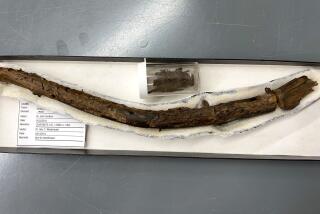The Easy Years
An amateur gardener whom we know reports that one of his favorite flowers is Alyogyne huegelii --sometimes called the blue hibiscus, which it isnât. He likes it because it is a handsome shrub that blooms on and off all year long, with vivid deep-blue flowers, and, perhaps most important, it thrives on the kind of neglect for which his garden is distinguished. That is hardly surprising because, we learned the other day, a lot of serious people have been working for 30 years to produce this happy combination of plant beauty and easy care.
The late George H. Spalding, then the superintendent of the Los Angeles State and County Arboretum in Arcadia, brought the seeds to the United States in 1959 from a six-month trip to Australia gathering all sorts of ornamental material. The arboretum people played around with the plant for almost 10 years before releasing it as worthy of California gardens, and since then some improvements have been made. So many, in fact, that it is not easy to trace the origins and assess the credit.
Ray T. Collett, the director of the arboretum at UC Santa Cruz, is regarded as the principal alyogyne hero, doing so many painstaking crossings of different plants that his staff has lost count. So it is not an accident that the most popular cultivar is dubbed Santa Cruz. But that nomenclature is mildly embarrassing to the people at Santa Cruz, who are not really sure that they developed the version named for their arboretum and, in any event, have another cultivar that they regard as distinctly superior. They call it Swan River after an area of western Australia with historic connections to this plant.
Efforts to improve the species do not end there. Yet another cultivar is only now going into production at Monrovia Nursery Co. in Azusa, one of the major wholesale plant producers. âIt has more compact growth and deeper-shaded flowers,â Audrey Teasdale, botanist at the nursery, said. So far it is not even named. The plant itself came from the Huntington Botanical Gardens in San Marino. It is one of a half-dozen cultivars from UC Santa Cruz grown over the years at the Huntington, most of them known only by numbers.
Names are a real problem with this plant, according to Kathy Musial, botanist at the Huntington Gardens. One name, Monterey Bay, has been assigned to two different cultivars. Commercial nurseries have assigned different names to the same clone. About the only thing that one can be sure of, she said, is that almost all the popular cultivars were developed by UC Santa Cruz.
Name problems have been part of this plant from the time of its arrival in this country. The Los Angeles Arboretum first named it Hibiscus huegelii when it was introduced 20 years ago. That was changed once there was agreement that it really was not a hibiscus. The summer edition of the California Arboretum Foundation News reports that long before George Spalding came home with his seeds, Europeans--among them an Austrian, a Baron von Hugel--were busy collecting. The baron visited Swan River in 1833 and carried home to Vienna a collection of ornamentals. Thus the species name, huegelii. And the UC Santa Cruz cultivar, Swan River.
One note of caution comes from Brett Hall, the manager of the UC Santa Cruz Arboretum. Regular pruning improves the growth. And there is a drawback to alyogyne. âThey are fairly short lived,â Kathy Musial reported. âMost live only three or four years. That is typical of many Australian plants.â
Nevertheless, we can hear our gardener friend commenting: âYes, but what easy years.â






